This report is part of the Series on Financial Markets and Regulation and was produced by the Brookings Center on Regulation and Markets.
Nearly 74 million people, about a quarter of the United States population, live in rural areas. That includes 15 million people of color. But according to the authors of a new paper published by the Center on Regulation and Markets at Brookings, these families are often overlooked in policy discussions on proposed changes to the Government Sponsored Enterprises (GSEs), which provide the largest share of mortgage financing in rural areas.
GSE mortgage financing meets a critical rural housing need, and it also supports community banks, which are often the only full-service financial institution in many rural areas. How mortgage financing is supported in the future will profoundly affect lending in rural communities and the health of community banks and credit unions.
In “Supporting Mortgage Lending in Rural Communities” (PDF), Michael Calhoun, Tom Feltner, and Peter Smith analyze the most recent data on rural mortgage lending and review how proposed housing finance reform would affect lending in rural areas as well as the community banks and credit unions that serve those areas.
They find that rural lending made up nearly one out of every five mortgage loans originated in the United States in 2016, with large depositories, community banks and credit unions, and nondepositories active in a competitive rural market. Community banks and credit unions, in particular, played a critical role in providing access to mortgage credit, and the GSEs were the largest providers of financing for rural mortgage lending.
The GSEs purchased over 2.4 million home purchase and refinance mortgage loans in 2016, including nearly a half a million loans to low- and moderate-income borrowers, over 450,000 loans to borrowers of color, and nearly 400,000 loans originated by community banks and credit unions.
The authors argue that GSEs provide a number of features that are essential for community banks. First is the GSEs’ cash window, which provides lenders the option of selling individual loans. This means that smaller institutions do not have to trade their loans for securities or sell their loans to other large banks.
Another advantage of the current cash window is that the GSEs purchase these loans without requiring the transfer of the servicing of the loans to a third party. This enables the community banks and credit unions to continue the relationship with the customer during the life of the loan rather than having the loan serviced by a third party or even a competitor.
The current cash window also provides comparable pricing to trading for securities. This is critical, as options such as the cash window are viable only if the pricing is at a level that permits community banks to be competitive in the mortgage market.
The authors also write that the proposals for housing reform have provisions that would tilt the government supported mortgage market heavily against community banks. While most options preserve some form of a cash window, they do not have the supporting protections that make it workable. These proposals, according to the authors, would make securities resulting from small groups of loans from many lenders measurably more expensive to assemble. They would also still lack the size to create enough loans to provide the large volume of securities for the economies of scale and liquidity that investors in securities desire, and this would also reduce the price community banks received for the mortgages.
The authors suggest that these proposed changes to the housing finance system could substantially reduce the ability of community banks to effectively access mortgage funding and serve consumers in rural communities. Thus, they argue that any reform must maintain the key features essential to providing community banks the means to compete effectively.
Read the full report here.
The authors did not receive financial support from any firm or person for this article or from any firm or person with a financial or political interest in this article. Neither is currently an officer, director, or board member of any organization with a financial or political interest in this article.
The Brookings Institution is committed to quality, independence, and impact.
We are supported by a diverse array of funders. In line with our values and policies, each Brookings publication represents the sole views of its author(s).









